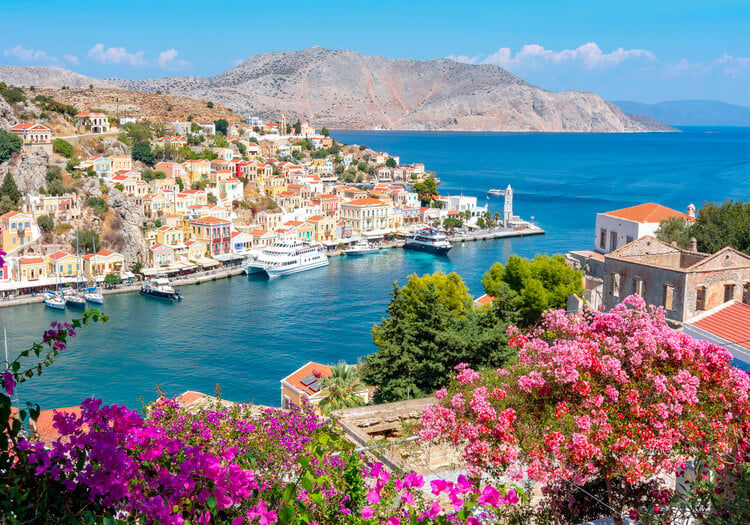Covering 3.931 million square miles, Europe is a pretty big place. From the Arctic tundra of northern Scandinavia to the balmy beaches of the Mediterranean, the continent is home to a wondrous variety of sights and experiences, and some of the most fantastic vacation destinations on Earth. But you may be wondering; when is the best time of year to visit Europe? How can you successfully plan a Europe vacation when there is much to see, do and consider? That’s where we come in. We’ve put together this handy guide to the best times to visit Europe, including seasonal weather, crowds, beaches, and much more.
When to visit Europe for great weather
It’s hard to sum up all of Europe’s weather in one word, so we’ll go with ‘varied.’ In truth, the type of weather you can expect on your European adventure depends greatly on where and when you choose to visit. There are places you can go in Europe for guaranteed sun and fun year-round (Spain’s Canary Islands are famously warm even in the depths of winter), and equally, places that are perfect for a snowy adventure. In this section, we take a look at some of our favorite European destinations by season, and what you can expect from the weather.
Spring weather in Europe
Best for; City breaks
| Destination | Average max temp (F) | Average min temp (F) | Av. rainfall days | Av. snowfall days |
| Marbella (Spain) | 70 | 52 | 12 | 0 |
| Paris (France) | 62 | 45 | 17 | 1 |
| Algarve (Portugal) | 70 | 56 | 11 | 0 |
| Rome (Italy) | 61 | 51 | 14 | 0 |
| Malta | 67 | 57 | 10 | 0 |
| Dubrovnik (Croatia) | 64 | 52 | 17 | 0 |
| Santorini (Greece) | 66 | 60 | 9 | 0 |
| Tenerife (Spain) | 76 | 64 | 7 | 0 |
Spring is a beautiful time in Europe. Across the continent, the days are getting longer, and the temperatures begin to rise. The weather in Europe in March, the first month of Spring, is generally still chilly, particularly at night, and some destinations (such as Paris and the mountains of France, Switzerland, and Italy), still see snowfall. In April, things are starting to get a bit brighter. Flowers begin to bloom and iconic destinations, such as the Greek islands, open for the tourist season. The weather in Europe in May is perfect in many tourist hotspots. It is also the best time to visit southern Europe to avoid the soaring temperatures of summer. Capital cities such as Rome and Paris benefit from the golden light of Spring, while the warm temperatures are far better for exploring than the high temperatures of Summer.
What to pack for a spring visit to Europe
Spring in Europe is a mixed bag, weather-wise. Early in the season, temperatures will be cold; as low as 45F in Northern France and even colder in the snowy countries of Scandinavia. So if you’re visiting in March or early April, a warm coat and plenty of layers to wrap up in will help keep the chill at bay. The weather in Europe during Spring can also be rather wet, even into May. A good travel umbrella and a light waterproof jacket ensure that your sightseeing won’t be interrupted by showers.

Summer weather in Europe
Best for: beach vacations
| Destination | Average max temp (F) | Average min temp (F) | Av. rainfall days | Av. snowfall days |
| Marbella (Spain) | 87 | 66 | 2 | 0 |
| Paris (France) | 77 | 59 | 18 | 1 |
| Algarve (Portugal) | 83 | 66 | 11 | 3 |
| Rome (Italy) | 86 | 78 | 11 | 0 |
| Malta | 85 | 77 | 2 | 0 |
| Dubrovnik (Croatia) | 84 | 70 | 14 | 0 |
| Santorini (Greece) | 81 | 76 | 2 | 0 |
| Tenerife (Spain) | 88 | 75 | 2 | 0 |
Summer is the most famous and popular time to visit Europe for great weather, and for good reason. From June through August, the mercury rises to the high 80’s in the south, which is the ideal temperature for spending lazy vacation days on the beaches of the Mediterranean. The weather tends to be the hottest across the board in July, with June and August being just a touch cooler. Classic European beach destinations, such as Marbella in Spain and Santorini in Greece, are also very dry during the summer, only seeing an average of 2 rainy days across the three-month period from June to August.
What to pack for summer in Europe
For any season in Europe, the key to comfort is to pack layers. If you’re off on a beach vacation to Spain, the South of France, or Greece, you can stick with light clothing and plenty of sun protection. For city breaks in the summer, it would be wise to pack a light rain jacket, particularly for popular destinations Paris and Dubrovnik, which are prone to short, heavy showers.

Autumn weather in Europe
Best for: Active, outdoors vacations
| Destination | Average max temp (F) | Average min temp (F) | Av. rainfall days | Av. snowfall days |
| Marbella (Spain) | 73 | 57 | 10 | 0 |
| Paris (France) | 62 | 49 | 19 | 0 |
| Algarve (Portugal) | 74 | 61 | 16 | 0 |
| Rome (Italy) | 72 | 58 | 16 | 0 |
| Malta | 76 | 68 | 13 | 0 |
| Dubrovnik (Croatia) | 69 | 58 | 16 | 0 |
| Santorini (Greece) | 73 | 70 | 9 | 0 |
| Tenerife (Spain) | 81 | 70 | 8 | 0 |
Fall is a particularly beautiful time in Europe, particularly in wild and rural places. The colors of the leaves on the trees slowly change from fresh green to russet and burnt orange, and warm days are coupled with crisp, clear nights and misty mornings. The temperatures start to drop off in cities and northern destinations, although southern places cling to high temperatures until late October. The biggest change in weather from the summer is the number of rainy days you can expect. Even dry resorts such as Marbella and the Algarve see significant rainfall in the autumn months.
What to pack for Autumn in Europe
Be prepared for change, and you won’t go wrong. Europe in Fall is a mixed bag, with some days hot and sunny and others, wet, windy and cold. Pack for every eventuality and you’ll be covered for whatever the weather throws at you. Even if you’re going somewhere, such a Mallorca or Tenerife, which holds onto sunshine and warm temperatures year-round, there’s always a chance of an odd rainy day or cold night in the Fall.

Winter weather in Europe
Best for: Skiing vacations, festive celebrations, or winter sun
| Destination | Average max temp (F) | Average min temp (F) | Av. rainfall days | Av. snowfall days |
| Marbella (Spain) | 59 | 47 | 12 | 0 |
| Paris (France) | 47 | 37 | 19 | 2 |
| Algarve (Portugal) | 62 | 50 | 14 | 0 |
| Rome (Italy) | 55 | 43 | 15 | 0 |
| Malta | 62 | 55 | 17 | 0 |
| Dubrovnik (Croatia) | 50 | 41 | 16 | 1 |
| Santorini (Greece) | 60 | 38 | 17 | 0 |
| Tenerife (Spain) | 72 | 62 | 10 | 0 |
Winter is the most varied time for weather in Europe. Some places, such as Iceland, Norway, and the Alpine regions are knee-deep in snow by mid-December, while others, such as Portugal’s Algarve, Spain’s Canary Islands, and Malta are basking in 60 degrees temperatures and higher. For fans of snowy adventures, winter is of course the best time to hit the slopes in Italy, Switzerland, and France, with steady snowfall from December through February.
What to pack for winter in Europe
If you’re going anywhere other than one of the winter sun destinations, you’ll need to take plenty of thick, woolly coats, hats, gloves, and scarves. Many places in Europe are not only cold, but windy, which makes the temperature feel even lower. Sturdy shoes are also a must for winter in Europe, as nothing ruins a sightseeing day more than wet, cold feet.

When to visit Europe to beat the crowds
As we mentioned earlier, Europe is an extremely popular destination, and certain times of year see millions of tourists from all over the world descend on beaches, cities, and resorts. For many people, being squashed onto a stretch of sand with hundreds of other people like sardines in a tin is not the most attractive way to spend a vacation. The good news is, there are absolutely times when you can plan a European vacation to avoid the crowds.
When is Europe busiest?
Across the continent, Summer is the peak season, It doesn’t matter if you’re watching sunsets on Santorini, trying tapas in Spain, or exploring the beaches of northern France, between June and August, it is going to be busy. August is the busiest month across Europe and is the peak time for family vacations.
Many European destinations are also crowded during the festive holiday season, particularly throughout December. Millions of tourists head to the famed Christmas markets of Germany, The Netherlands, France, and Czechia at this time of year. Ski resorts are also very busy in December, and during the school break in February.

When to visit Europe for fewer crowds
The shoulder seasons are widely regarded as the best time to visit Europe to avoid crowds. Popular cities such as Paris, Barcelona, Rome, and Athens see much lighter footfall during the spring and fall months than in the summer and winter. Attractions are less crowded, beaches are emptier and, as a result, prices are lower. March is generally the quietest month across the board, with a small spike in numbers in April for Easter celebrations. May is the best month to visit Europe for a compromise between good weather and fewer crowds than in the peak season, although visitor numbers begin to creep up during the month.
September, when European schools restart, is a good time to enjoy the last of the summer sun with fewer families around, while October and November see low numbers of people and chillier weather setting in.
When to visit Europe for a beach vacation
The best time to visit Europe’s beaches is in May and September for the majority of destinations. This is because the Mediterranean, Balkan and Aegean resorts are enjoying high temperatures and calm seas, without the thronging crowds of the peak summer season.
If you’re visiting winter sun destinations, such as Tenerife or the Algarve, you have even more options. If you are hoping for a bit of vitamin sea to chase the winter blues away, then November through March is a great time to take advantage of cheaper flight prices and bask in winter warmth.

When is the best time to visit Europe for a ski vacation?
Europe is home to some of the best ski resorts on Earth, attracting winter sports fans and top-class athletes from all over the world. Ski vacations in Europe are all about glamour, with resorts such as Chamonix and Zermatt providing equal doses of glittering skiing, nightlife and cozy, rustic alpine living. For top skiing, you need good snow and lots of it. Thankfully, the Alpine regions of France, Italy, Switzerland, and Austria offer just that, between late November and March. Other popular regions for skiing in Europe include the Pyrenees on the Spain-France border, the Pirin Mountains in Bulgaria, and the Sierra Nevadas in Spain. Check out our guide for more information on fabulous ski vacations in Europe.

Book a luxury vacation home in Europe with Top Villas
From chic townhouses in the South of France to whitewashed villas in the Greek Islands, we have a spectacular range of luxurious villas in Europe. Our rental homes are all carefully selected according to exacting standards, to ensure that you have the ultimate exclusive European getaway. Our knowledgeable experts are on hand to help you organize everything for your vacation, from the moment you book to when you arrive home.




